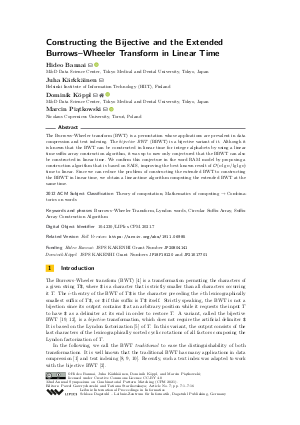Constructing the Bijective and the Extended Burrows-Wheeler Transform in Linear Time
Authors
Hideo Bannai  ,
Juha Kärkkäinen,
Dominik Köppl
,
Juha Kärkkäinen,
Dominik Köppl  ,
Marcin Piątkowski
,
Marcin Piątkowski 
-
Part of:
Volume:
32nd Annual Symposium on Combinatorial Pattern Matching (CPM 2021)
Part of: Series: Leibniz International Proceedings in Informatics (LIPIcs)
Part of: Conference: Annual Symposium on Combinatorial Pattern Matching (CPM) - License:
 Creative Commons Attribution 4.0 International license
Creative Commons Attribution 4.0 International license
- Publication Date: 2021-06-30
File

PDF
LIPIcs.CPM.2021.7.pdf
- Filesize: 0.82 MB
- 16 pages
Document Identifiers
Related Versions
- Full Version https://arxiv.org/abs/1911.06985
Subject Classification
ACM Subject Classification
- Theory of computation
- Mathematics of computing → Combinatorics on words
Keywords
- Burrows-Wheeler Transform
- Lyndon words
- Circular Suffix Array
- Suffix Array Construction Algorithm
Metrics
- Access Statistics
-
Total Accesses (updated on a weekly basis)
0PDF Downloads0Metadata Views
Abstract
The Burrows-Wheeler transform (BWT) is a permutation whose applications are prevalent in data compression and text indexing. The bijective BWT (BBWT) is a bijective variant of it. Although it is known that the BWT can be constructed in linear time for integer alphabets by using a linear time suffix array construction algorithm, it was up to now only conjectured that the BBWT can also be constructed in linear time. We confirm this conjecture in the word RAM model by proposing a construction algorithm that is based on SAIS, improving the best known result of O(n lg n / lg lg n) time to linear. Since we can reduce the problem of constructing the extended BWT to constructing the BBWT in linear time, we obtain a linear-time algorithm computing the extended BWT at the same time.
Cite As Get BibTex
Hideo Bannai, Juha Kärkkäinen, Dominik Köppl, and Marcin Piątkowski. Constructing the Bijective and the Extended Burrows-Wheeler Transform in Linear Time. In 32nd Annual Symposium on Combinatorial Pattern Matching (CPM 2021). Leibniz International Proceedings in Informatics (LIPIcs), Volume 191, pp. 7:1-7:16, Schloss Dagstuhl – Leibniz-Zentrum für Informatik (2021)
https://doi.org/10.4230/LIPIcs.CPM.2021.7
BibTex
@InProceedings{bannai_et_al:LIPIcs.CPM.2021.7,
author = {Bannai, Hideo and K\"{a}rkk\"{a}inen, Juha and K\"{o}ppl, Dominik and Pi\k{a}tkowski, Marcin},
title = {{Constructing the Bijective and the Extended Burrows-Wheeler Transform in Linear Time}},
booktitle = {32nd Annual Symposium on Combinatorial Pattern Matching (CPM 2021)},
pages = {7:1--7:16},
series = {Leibniz International Proceedings in Informatics (LIPIcs)},
ISBN = {978-3-95977-186-3},
ISSN = {1868-8969},
year = {2021},
volume = {191},
editor = {Gawrychowski, Pawe{\l} and Starikovskaya, Tatiana},
publisher = {Schloss Dagstuhl -- Leibniz-Zentrum f{\"u}r Informatik},
address = {Dagstuhl, Germany},
URL = {https://drops.dagstuhl.de/entities/document/10.4230/LIPIcs.CPM.2021.7},
URN = {urn:nbn:de:0030-drops-139588},
doi = {10.4230/LIPIcs.CPM.2021.7},
annote = {Keywords: Burrows-Wheeler Transform, Lyndon words, Circular Suffix Array, Suffix Array Construction Algorithm}
}
Author Details
Funding
- Bannai, Hideo: JSPS KAKENHI Grant Number JP20H04141
- Köppl, Dominik: JSPS KAKENHI Grant Numbers JP18F18120 and JP21K17701
References
-
Donald Adjeroh, Timothy Bell, and Amar Mukherjee. The Burrows-Wheeler Transform: Data Compression, Suffix Arrays, and Pattern Matching. Springer, 2008.

-
Hideo Bannai, Juha Kärkkäinen, Dominik Köppl, and Marcin Piatkowski. Indexing the bijective BWT. In Proc. CPM, volume 128 of LIPIcs, pages 17:1-17:14, 2019.

-
Silvia Bonomo, Sabrina Mantaci, Antonio Restivo, Giovanna Rosone, and Marinella Sciortino. Sorting conjugates and suffixes of words in a multiset. Int. J. Found. Comput. Sci., 25(8):1161, 2014.

-
Michael Burrows and David J. Wheeler. A block sorting lossless data compression algorithm. Technical Report 124, Digital Equipment Corporation, Palo Alto, California, 1994.

-
Kuo Tsai Chen, Ralph H. Fox, and Roger C. Lyndon. Free differential calculus, IV. The quotient groups of the lower central series. Annals of Mathematics, pages 81-95, 1958.

-
Francesco Dolce, Antonio Restivo, and Christophe Reutenauer. On generalized Lyndon words. Theor. Comput. Sci., 777:232-242, 2019.

-
Jean-Pierre Duval. Factorizing words over an ordered alphabet. J. Algorithms, 4(4):363-381, 1983.

-
Paolo Ferragina and Giovanni Manzini. Opportunistic data structures with applications. In Proc. FOCS, pages 390-398, 2000.

-
Paolo Ferragina and Giovanni Manzini. Indexing compressed text. J. ACM, 52(4):552-581, 2005.

-
Travis Gagie, Gonzalo Navarro, and Nicola Prezza. Optimal-time text indexing in BWT-runs bounded space. In Proc. SODA, pages 1459-1477, 2018.

-
Daniel Gibney and Sharma V. Thankachan. Finding an optimal alphabet ordering for Lyndon factorization is hard. In Proc. STACS, volume 187 of LIPIcs, pages 35:1-35:15, 2021.

- Joseph Yossi Gil and David Allen Scott. A bijective string sorting transform. ArXiv 1201.3077, 2012. URL: http://arxiv.org/abs/1201.3077.
-
Keisuke Goto. Optimal time and space construction of suffix arrays and LCP arrays for integer alphabets. In Proc. PSC, pages 111-125, 2019.

-
Wing-Kai Hon, Tsung-Han Ku, Chen-Hua Lu, Rahul Shah, and Sharma V. Thankachan. Efficient algorithm for circular Burrows-Wheeler transform. In Proc. CPM, volume 7354 of LNCS, pages 257-268, 2012.

-
Wing-Kai Hon, Chen-Hua Lu, Rahul Shah, and Sharma V. Thankachan. Succinct indexes for circular patterns. In Proc. ISAAC, volume 7074 of LNCS, pages 673-682, 2011.

-
Guy Jacobson. Space-efficient static trees and graphs. In Proc. FOCS, pages 549-554, 1989.

-
Juha Kärkkäinen, Peter Sanders, and Stefan Burkhardt. Linear work suffix array construction. J. ACM, 53(6):918-936, 2006.

-
Pang Ko and Srinivas Aluru. Space efficient linear time construction of suffix arrays. J. Discrete Algorithms, 3(2-4):143-156, 2005.

-
Manfred Kufleitner. On bijective variants of the Burrows-Wheeler transform. In Proc. PSC, pages 65-79, 2009.

-
Zhize Li, Jian Li, and Hongwei Huo. Optimal in-place suffix sorting. In Proc. SPIRE, volume 11147 of LNCS, pages 268-284, 2018.

-
R. C. Lyndon. On Burnside’s problem. Transactions of the American Mathematical Society, 77(2):202-215, 1954.

-
Sabrina Mantaci, Antonio Restivo, Giovanna Rosone, and Marinella Sciortino. An extension of the Burrows-Wheeler transform. Theor. Comput. Sci., 387(3):298-312, 2007.

-
Ge Nong, Sen Zhang, and Wai Hong Chan. Two efficient algorithms for linear time suffix array construction. IEEE Trans. Computers, 60(10):1471-1484, 2011.

